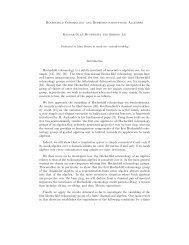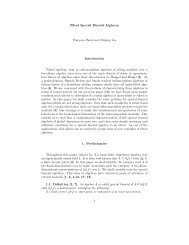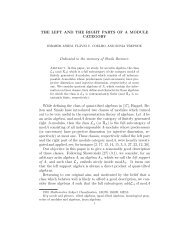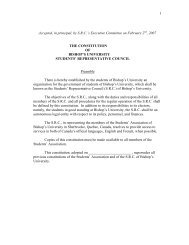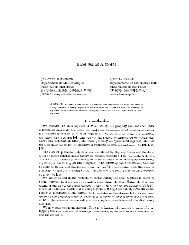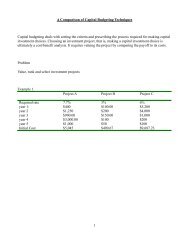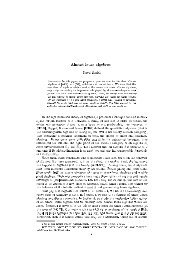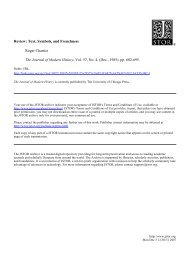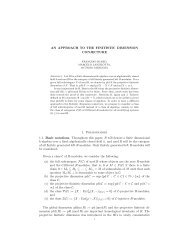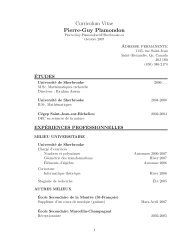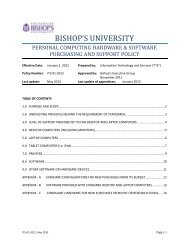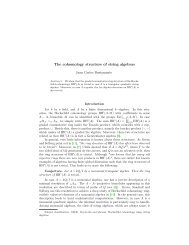Biological Sciences - Bishop's University
Biological Sciences - Bishop's University
Biological Sciences - Bishop's University
Create successful ePaper yourself
Turn your PDF publications into a flip-book with our unique Google optimized e-Paper software.
154 • Bishop’s <strong>University</strong> 2013/2014<br />
BIO 329b Invertebrate Zoology 3-3-0<br />
Morphology, physiology, embryology, evolution and classification of invertebrate animals.<br />
Prerequisite: BIO 205a; Co-requisite: BIL 329b<br />
Students with credit for BIO 248 cannot also receive credit for BIO 329.<br />
Professor Savage<br />
BIL 329b Invertebrate Zoology Laboratory 1-0-3<br />
The classification, identification, morphology and biology of the animals considered<br />
in BIO 329b.<br />
Co-requisite: BIO 329b<br />
Students with credit for BIL 248 cannot also receive credit for BIL 329.<br />
Professor Savage<br />
BIO 330* Ornithology 3-3-0<br />
An introduction to the study of birds, including their structure, function, reproduction,<br />
evolution and classification. The integration of morphological, physiological, and<br />
behavioral adaptations will be emphasized. In addition, topics of particular relevance to<br />
birds such as mechanisms of flight, migration, vocal communication, and conservation<br />
will be discussed.<br />
Prerequisite: BIO 205a; Co-requisite: BIL 330<br />
Staff<br />
BIL 330* Ornithology Laboratory 1-0-3<br />
Study of bird morphology using preserved specimens and museum study skins. Field<br />
trips will be used to learn about living birds and their identification.<br />
Prerequisite: BIO 205a; Co-requisite: BIO 330<br />
Staff<br />
BIO 331a* Freshwater Biology 3-3-0<br />
This course will expose students to the biological importance and diversity of freshwater<br />
systems. Class material will look at both the biotic and abiotic components of<br />
aquatic systems as well as their interactions.<br />
Prerequisite or Co-requisite: BIO 205a; BIO 207a; Co-requisite: BIL 331a<br />
Students with credit for BIL 230 cannot also receive credit for BIL 331.<br />
Professor Richardson<br />
BIL 331a* Freshwater Biology Lab 1-3-0<br />
The lab section will focus on the different techniques necessary for sampling both lentic<br />
and lotic systems. Emphasis will be placed on practical first-hand experience using the<br />
appropriate equipment in the field. The process of data collection will culminate in the<br />
students performing a mini-research project on a local aquatic system of their choice<br />
and presenting these data to their peers.<br />
Prerequisite or Co-requisite: BIO 205a; BIO 207a; Co-requisite: BIO 331a<br />
Students with credit for BIL 230 cannot also receive credit for BIL 331.<br />
Professor Richardson<br />
BIO 332a Vertebrate Zoology 3-3-0<br />
Evolution, classification, morphology, and physiology of the various classes of vertebrates.<br />
Particular attention will be placed upon the integumentary, skeletal, muscular,<br />
respiratory, digestive, excretory, and reproductive systems.<br />
Prerequisite: BIO 205a; Co-requisite BIL 332a<br />
Students with credit for BIO 270 cannot also receive credit for BIO 332.<br />
Professor Richardson<br />
BIL 332a Vertebrate Zoology Laboratory 1-0-3<br />
The lab component will expose students to the diversity of vertebrates around them.<br />
Vertebrate diversity and behavior will be studied through a series of field trips, while<br />
basic anatomy will be examined in more detail in the lab through dissections and preserved<br />
mounts.<br />
Prerequisite: BIO 205a; Co-requisite: BIO 332a<br />
Students with credit for BIL 270 cannot also receive credit for BIL 332.<br />
Professor Richardson<br />
BIO 336a Animal Physiology I 3-3-0<br />
Basic mechanisms of homeostatic regulation. Topics include: Cell physiology, Nervous<br />
system, Muscular system, and the Cardiovascular system.<br />
Prerequisite: BIO 197 or BIO 110; Co-requisite: BIL 336a<br />
Students who have received credit for BIO 226a cannot also receive credit for<br />
BIO 336a.<br />
Professor Hull<br />
BIL 336a Animal Physiology I Laboratory 1-0-3<br />
Experiments designed to examine the physiological systems discussed in BIO 336a.<br />
Co-requisite: BIO 336a<br />
Students who have received credit for BIL 226 cannot also receive credit for BIL 336.<br />
Professor Hull<br />
BIO 337b Animal Physiology II 3-3-0<br />
Mechanisms of functional operation of animal organisms. Topics include: renal, respiratory,<br />
gastrointestinal, and reproductive function.<br />
Prerequisite: BIO 336a; Co-requisite: BIL 337b<br />
Students who have received credit for BIO 228 cannot also receive credit for BIO 337.<br />
Professor Hull<br />
BIL 337b Animal Physiology II Laboratory 1-0-3<br />
Experiments dealing with different aspects of animal physiology. Some experiments<br />
will be performed using computer simulations.<br />
Co-requisite: BIO 337b<br />
Students who have received credit for BIL 228 cannot also receive credit for BIL 337.<br />
Professor Hull<br />
BIO 345b Plant Physiology 3-3-0<br />
Nutrition, transport, growth and development in plants; the water relations of plants;<br />
mineral nutrition; growth regulators; tropisms; photoperiodism; vernalization and dormancy.<br />
Prerequisite: BIO 206b<br />
Offered in odd-numbered winters<br />
Professor van Hulst<br />
BIO 349a Medical and Forensic Entomology 3-3-0<br />
As one of the most important group of disease vectors, insects and other arthropods are<br />
involved in the transmission of numerous pathogens causing diseases such as malaria,<br />
the plague, sleeping sickness, scabies, West Nile fever, and Lyme disease. This course<br />
will introduce students to some of the basic concepts of medical entomology with a<br />
focus on selected diseases. Information on the life cycles of insect vectors and the<br />
pathogens they carry is presented, as well as symptoms, treatment and geographical<br />
distribution of selected arthropod-borne diseases. The relevance of entomological evidence<br />
in criminal investigations (such as the use of insects to determine post-mortem<br />
interval is also discussed.<br />
Prerequisite BIO 205a<br />
Offered in odd-numbered autumns.<br />
Professor Savage<br />
BIO 350* Invertebrate Physiology 3-3-0<br />
This course provides an overview of some physiological mechanisms of invertebrates<br />
including digestion and nutrition, respiration, excretion, reproduction, circulation, locomotion,<br />
and behavior. We will also consider some of the unique strategies used by<br />
invertebrates which allow them to thrive in Earth’s most extreme and challenging environments:<br />
deserts, frozen wastelands, deep ocean floors, hot vents, inside other organisms,<br />
and hypersaline lakes.<br />
Prerequisite: BIO 105a<br />
Professor Savage<br />
BIO 352a Microbiology 1-0-3<br />
An introduction to prokaryotic microorganisms, eukaryotic microorganisms, and viruses;<br />
their ecology, growth characteristics, and host interactions. Examination of the environmental<br />
roles of microbes as well as their impact on the human world.<br />
Prerequisite: BIO 195a; Co-requisite: BIL 352a<br />
Offered in odd-numbered autumns.<br />
Professor Stroeher<br />
BIL 352a Microbiology Laboratory 1-0-3<br />
An introduction to common microbiological techniques used in medical, biological and<br />
biochemical research, including techniques in growth, staining and identification of<br />
bacteria and viruses. As well, the diversity of physiological and metabolic requirements<br />
of bacteria will be examined.<br />
Co-requisite: BIO 352a<br />
Offered in odd-numbered autumns<br />
Professor Stroeher<br />
BIO 354 Insect Biodiversity 3-3-0<br />
With close to a million described species, insects form more than 70% of animal diversity.<br />
But in spite of such overwhelming diversity they are poorly known and consequently<br />
often excluded from biodiversity studies. The main goal of this course is to teach the students<br />
how to collect, preserve and identify insects, especially those found in eastern North<br />
America. In addition to using material housed in the Bishop’s insect collection, material<br />
collected in the field by each student will be prepared in a fashion that will make the spec-



